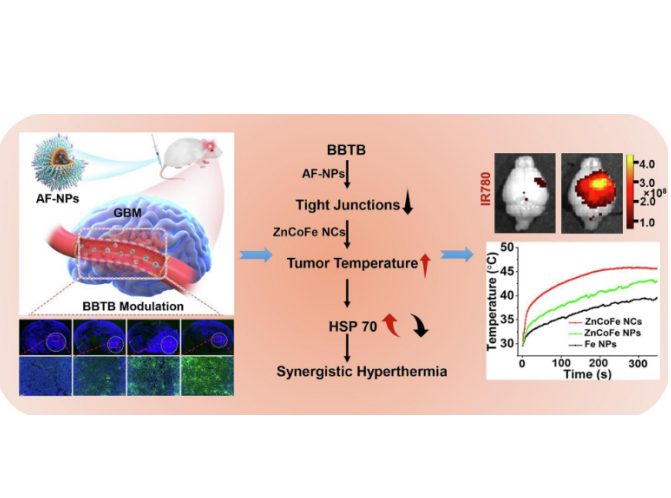文献:Modulation of blood-brain tumor barrier for delivery of magnetic hyperthermia to brain cancer
文献链接:https://www.sciencedirect.com/science/article/abs/pii/S0168365923000810
作者:Haoan Wu, Lei Liu, Ming Ma, Yu Zhang
相关产品:
MPEG2K-SeSe-NH2 甲氧基聚乙二醇2K-双硒键-氨基
Mal-PEG2K-SeSe-NH2 马来酰亚胺-聚乙二醇2K-双硒键-氨基
6-caprolactone 6-己内酯
PDLLA10k-PEG5k 聚(D,L-乳酸)10k-聚乙二醇 5k
原文摘要:Glioblastoma (GBM) is the most invasive brain tumor and remains lack of effective treatment. The existence of blood-brain tumor barrier (BBTB) constitutes the greatest barrier to non-invasive delivery of therapeutic agents to tumors in the brain. Here, we propose a novel approach to specifically modulate BBTB and deliver magnetic hyperthermia in a systemic delivery mode for the treatment of GBM. BBTB modulation is achieved by targeted delivering fingolimod to brain tumor region via dual redox responsive PCL-SeSe-PEG (poly (ε-caprolactone)-diselenium-poly (ethylene glycol)) polymeric nanocarrier. As an antagonist of sphingosine 1-phosphate receptor-1 (S1P1), fingolimod potently inhibits the barrier function of BBB by blocking the binding of sphingosine 1-phosphate (S1P) to S1P1 in endothelial cells. We found that the modulated BBTB showed slight expression level of tight junction proteins, allowing efficient accumulation of zinc- and cobalt- doped iron oxide nanoclusters (ZnCoFe NCs) with enhanced magnetothermal conversion efficiency into tumor tissues through the paracellular pathway. As a result, the co-delivery of heat shock protein 70 inhibitor VER-155008 with ZnCoFe NCs could realize synergistic magnetic hyperthermia effects upon exposure to an alternating current magnetic field (ACMF) in both GL261 and U87 brain tumor models. This modulation approach brings new ideas for the treatment of central nervous system diseases that require delivery of therapeutic agents across the blood-brain barrier (BBB).
Mal-PEG2K-SeSe-NH2是一种化合物。“Mal”代表马来酰亚胺基,它具有高反应活性,能与巯基(-SH)发生特异性的迈克尔加成反应,可用于将其连接到含巯基的生物分子如蛋白质、抗体等上。“PEG2K”表示聚乙二醇链段,分子量约为2000Da。聚乙二醇具有良好的亲水性和生物相容性,能增加化合物的水溶性,延长在体内的循环时间。“SeSe”代表二硒键,这是一种对氧化还原环境敏感的化学键。在细胞内的还原环境下,二硒键会发生断裂,从而实现化合物或生物分子的可控释放。“NH2”为氨基,它可以与多种带有羧基或活性酯的分子发生反应,进一步进行化学修饰。Mal-PEG2K-SeSe-NH2结合了多种功能基团的特性,在化合物递送、生物成像、生物传感器等生物医学领域展现出应用潜力。该文献提出了一种方法来特异性调节BBTB,BBTB调制是通过双氧化还原响应的pcl-sse-peg(聚(ε-己内酯)-二硒-聚(乙二醇))聚合物纳米载体靶向递送fingolimod。以下是基于Mal-PEG2K-SeSe-NH2等材料用于双氧化还原响应的PCL-SSe-PEG聚合物纳米载体的制备过程:

图:BBTB的调节机制
制备聚(ε-己内酯)-二硒-聚(乙二醇)(PCL-SSe-PEG)聚合物:以ε-己内酯为单体,在合适催化剂作用下开环聚合得到聚(ε-己内酯)(PCL)。合成含二硒键的连接体,将PEG与含二硒键连接体反应,再与PCL连接形成PCL-SSe-PEG聚合物。
纳米载体的初步组装:将PCL-SSe-PEG聚合物溶解在有机溶剂中,通过自组装形成纳米载体,利用透析或蒸发除去有机溶剂。
功能化修饰:加入MPEG2K-SeSe-NH2,通过化学反应将其连接到纳米载体表面,赋予纳米载体聚乙二醇化及二硒键响应特性。用Mal-PEG2K-SeSe-NH2修饰,马来酰亚胺基(Mal)可用于后续连接含巯基的生物分子,二硒键用于氧化还原响应。
荧光标记:将CY7-dextran加入体系,使其物理包载或化学连接到纳米载体上,用于后续的成像和追踪。
增强稳定性和性能调节:加入PDLLA10k-PEG5k,它可与PCL-SSe-PEG共组装,调节纳米载体的物理化学性质和稳定性。通过超滤、离心等方法纯化纳米载体,用动态光散射、透射电子显微镜等表征其粒径、形态等。

图:Mal结构式
结论:经过Mal-PEG2K-SeSe-NH2参与调节的BBTB显示出轻微的紧密连接蛋白表达水平,允许锌和钴掺杂氧化铁纳米团簇(ZnCoFe NCs)通过细胞旁途径高效积累,增强了磁热转化效率,进入tumor组织。热休克蛋白70VER-155008与ZnCoFe NCs在GL261和U87tumor模型中均可在交流磁场(ACMF)下实现协同磁热Therapeutic effect 应。

 2025-03-19 作者:ZJ 来源:
2025-03-19 作者:ZJ 来源:

